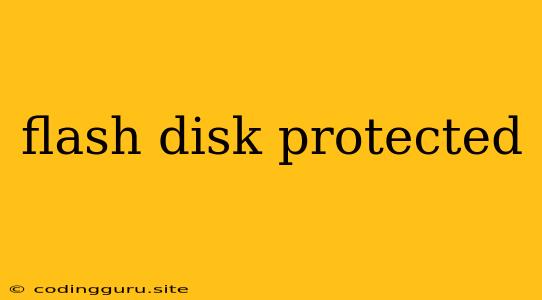Flash Disk Protected: Why It Happens and How to Fix It
Ever plugged in your flash drive only to find it's "protected"? This frustrating issue prevents you from saving files or even accessing existing data. But don't worry, it's not always a sign of a broken drive. Here's what you need to know about flash disk protected and how to fix it.
Why is My Flash Drive Protected?
Several reasons can lead to a flash drive being protected. Here are the most common:
-
Write Protection Switch: Many flash drives have a small physical switch that enables or disables write protection. This switch, typically found on the side or end of the drive, is meant to prevent accidental data deletion. If it's accidentally flipped to the "protected" position, it'll prevent you from writing data.
-
Software Lock: Some software programs, like security programs or file encryption tools, can lock down a drive to protect sensitive data. If you've installed such software, it might have accidentally activated write protection.
-
File System Errors: Corrupted files or a damaged file system can also trigger the "protected" status. This often happens due to improper removal, power surges, or even viruses.
-
Hardware Failure: In rare cases, the flash drive itself might be damaged, rendering it unusable.
How to Fix "Flash Disk Protected"
Here's a step-by-step guide to troubleshoot and fix the "flash disk protected" issue:
1. Check the Write Protection Switch:
- Look for a small switch on the side or end of the flash drive.
- Slide it to the "unprotected" position. This should allow you to write data again.
2. Check for Software Locks:
- Open your antivirus or security software and check for any settings that might be locking down the drive.
- If you use any file encryption tools, disable them temporarily and try again.
3. Use Disk Management (Windows):
- Open "Disk Management" by searching for it in the Start menu.
- Right-click on the drive letter representing your flash drive.
- Select "Format."
- Choose the desired file system (usually FAT32 for better compatibility).
- Click "Start." This will format the drive and erase all its contents.
4. Try a Different USB Port:
- Plug your flash drive into a different USB port on your computer.
- Sometimes, the port itself can cause problems, especially if it's faulty.
5. Run CHKDSK (Windows):
- Open Command Prompt as administrator.
- Type "chkdsk /f /r [drive letter]:", replacing "[drive letter]" with the letter of your flash drive.
- Press Enter. This will check and attempt to repair any file system errors.
6. Use Disk Utility (Mac):
- Open "Disk Utility" by searching for it in Spotlight.
- Select your flash drive from the list on the left.
- Click on the "First Aid" tab.
- Click "Run." This will check the drive for errors and attempt to repair them.
7. Use a Flash Drive Recovery Tool:
- If the above steps don't work, consider using a recovery tool like Recuva or EaseUS Data Recovery Wizard.
- These tools can help recover lost data and sometimes even repair a damaged flash drive.
8. Contact the Manufacturer:
- If none of the solutions work, your flash drive might be physically damaged.
- Contact the manufacturer for warranty support or replacement.
9. Formatting the Drive (Extreme Caution):
- Only use this as a last resort. Formatting your drive will erase all data!
- Open Disk Management or Disk Utility (depending on your operating system).
- Select your flash drive and choose "Format" or "Erase."
Tips for Preventing "Flash Disk Protected" in the Future:
- Always use the write protection switch carefully.
- Don't forcefully eject flash drives. Properly disconnect them from the computer.
- Use a reliable antivirus and security software.
- Keep your flash drive updated with the latest software.
- Avoid extreme temperatures and physical shocks.
Conclusion:
While the "flash disk protected" error can be frustrating, it's often fixable. By following these troubleshooting steps, you can regain access to your flash drive and continue using it without worry. Remember to take proper care of your flash drive and follow good practices to prevent this problem in the future.
